
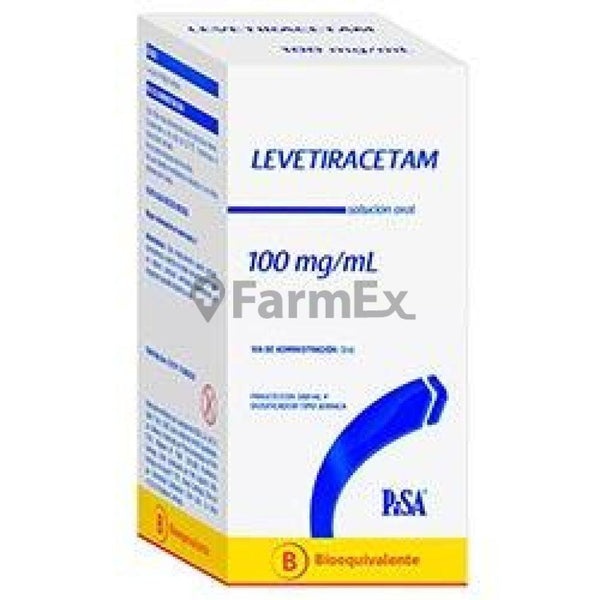
LEVETIRACETAM ACTAVIS GROUP 100 mg/ml ORAL SOLUTION

Ask a doctor about a prescription for LEVETIRACETAM ACTAVIS GROUP 100 mg/ml ORAL SOLUTION

How to use LEVETIRACETAM ACTAVIS GROUP 100 mg/ml ORAL SOLUTION
Introduction
Package Leaflet: Information for the Patient
Levetiracetam Actavis Group 100 mg/ml Oral Solution EFG
levetiracetam
Read the entire package leaflet carefully before you or your child starts taking this medicine, as it contains important information for you.
- Keep this package leaflet, as you may need to read it again.
- If you have any further questions, ask your doctor or pharmacist.
- This medicine has been prescribed for you only. Do not pass it on to others. It may harm them, even if their symptoms are the same as yours.
- If you experience any side effects, talk to your doctor or pharmacist. This includes any possible side effects not listed in this package leaflet. See section 4.
Contents of the package leaflet:
- What is Levetiracetam Actavis Group and what is it used for
- What you need to know before taking Levetiracetam Actavis Group
- How to take Levetiracetam Actavis Group
- Possible side effects
- Storage of Levetiracetam Actavis Group
- Contents of the pack and further information
1. What is Levetiracetam Actavis Group and what is it used for
Levetiracetam is an antiepileptic medicine (a medicine used to treat seizures in epilepsy).
Levetiracetam Actavis Group is used:
- on its own in adults and adolescents from 16 years of age with newly diagnosed epilepsy, to treat a certain form of epilepsy. Epilepsy is a condition where patients have fits (seizures). Levetiracetam is used to treat the form of epilepsy in which the seizures initially affect only one side of the brain, but may then spread to wider areas on both sides of the brain (partial onset seizures with or without secondary generalisation). Your doctor has prescribed levetiracetam for you to reduce the number of seizures.
- in combination with other antiepileptic medicines to treat:
- partial onset seizures with or without generalisation in adults, adolescents, children and infants from 1 month of age
- myoclonic seizures (short, shock-like jerks of a muscle or a group of muscles) in adults and adolescents from 12 years of age with juvenile myoclonic epilepsy,
- primary generalised tonic-clonic seizures (major fits, including loss of consciousness) in adults and adolescents from 12 years of age with idiopathic generalised epilepsy (a type of epilepsy that is thought to have a genetic cause).
2. What you need to know before taking Levetiracetam Actavis Group
Do not take Levetiracetam Actavis Group
- if you are allergic to levetiracetam, to pyrrolidone derivatives or to any of the other ingredients of this medicine (listed in section 6).
Warnings and precautions
Talk to your doctor before taking Levetiracetam Actavis Group
- If you have kidney problems, follow your doctor’s instructions. He/she will decide if you need to adjust the dose.
- If you notice any decrease in your child’s growth or an unexpected delay in puberty, contact your doctor.
- A small number of people taking antiepileptics such as levetiracetam have had thoughts of harming themselves or suicide. If you have any symptoms of depression and/or suicidal thoughts, contact your doctor.
- If you have a medical history or a family history of abnormal heart rhythms (visible on an electrocardiogram), or if you have a condition and/or are taking a treatment that may make you prone to cardiac arrhythmias or electrolyte disturbances.
Tell your doctor or pharmacist if any of the following side effects gets serious or lasts longer than a few days:
- Abnormal thoughts, feeling irritable or behaving more aggressively than usual or if you or your family and friends notice significant changes in your mood or behaviour.
- Worsening of epilepsy:
On rare occasions, epileptic fits may become worse or more frequent, mainly during the first month after starting treatment or after increasing the dose.
In a very rare form of epilepsy (early onset epilepsy associated with SCN8A mutations) that causes multiple types of epileptic fits and loss of skills, you may notice that the fits persist or worsen during treatment.
If you experience any of these new symptoms while taking Levetiracetam Actavis Group, see a doctor as soon as possible.
Children and adolescents
Monotherapy with Levetiracetam Actavis Group (taking only this medicine) is not indicated in children and adolescents under 16 years.
Using Levetiracetam Actavis Group with other medicines
Tell your doctor or pharmacist if you are taking, have recently taken or might take any other medicines.
Do not take macrogol (a laxative medicine) for one hour before and one hour after taking levetiracetam, as it may reduce its effect.
Pregnancy and breastfeeding
If you are pregnant or breastfeeding, think you may be pregnant or are planning to have a baby, ask your doctor or pharmacist for advice before taking this medicine.
Levetiracetam can only be used during pregnancy if, after a careful evaluation, your doctor considers it necessary.
Do not stop your treatment without discussing it with your doctor. The risk of birth defects for your baby cannot be completely excluded.
Breastfeeding is not recommended during treatment with Levetiracetam Actavis Group.
Driving and using machines
Levetiracetam Actavis Group may affect your ability to drive or use tools or machines, as it may cause drowsiness. This is more likely at the start of treatment or when the dose is increased. Do not drive or use machines until you are sure that your ability to perform such activities is not affected.
Levetiracetam Actavis Group contains methyl parahydroxybenzoate, propyl parahydroxybenzoate, mannitol, propylene glycol and sodium
It may cause allergic reactions (which can be delayed) because it contains methyl parahydroxybenzoate (E218) and propyl parahydroxybenzoate (E216). This medicine contains maltitol. If your doctor has told you that you have an intolerance to some sugars, consult them before taking this medicine. Levetiracetam Actavis Group 100 mg/ml oral solution EFG contains propylene glycol (E1520). If the baby is less than 4 weeks old, consult your doctor or pharmacist, especially if the baby has been given other medicines that contain propylene glycol or alcohol.
This medicine contains less than 1 mmol of sodium (23 mg) per ml; this is, essentially “sodium-free”.
3. How to take Levetiracetam Actavis Group
Follow exactly the instructions given to you by your doctor or pharmacist for taking this medicine. If you are not sure, consult your doctor or pharmacist again.
Levetiracetam Actavis Group should be taken twice daily, once in the morning and once in the evening, approximately at the same time each day.
Take the oral solution as instructed by your doctor.
Monotherapy (from 16 years of age)
Adults (≥18 years) and adolescents from 16 years of age:
Measure the appropriate dose using the 10 ml syringe provided in the pack for patients from 4 years of age onwards.
Recommended dose: Levetiracetam Actavis Group is taken twice daily, divided into two equal doses, each of 5 ml (500 mg) to 15 ml (1,500 mg).
When starting treatment with Levetiracetam Actavis Group, your doctor will prescribe a lower dose for 2 weeks before giving you the lowest daily dose.
Concomitant therapy
Dose in adults and adolescents (12 to 17 years):
Measure the appropriate dose using the 10 ml syringe provided in the pack for patients from 4 years of age onwards.
Recommended dose: Levetiracetam Actavis Group is taken twice daily, divided into two equal doses, each of 5 ml (500 mg) to 15 ml (1,500 mg).
Dose in children from 6 months of age onwards
Your doctor will prescribe the most appropriate pharmaceutical form of Levetiracetam Actavis Group according to the age, weight and dose.
For children from 6 months to 4 years, measure the appropriate dose using the 3 ml syringe provided in the pack.
For children over 4 years, measure the appropriate dose using the 10 ml syringe provided in the pack.
Recommended dose: Levetiracetam Actavis Group is taken twice daily, divided into two equal doses, each of 0.1 ml (10 mg) to 0.3 ml (30 mg) per kilogram of the child’s body weight (see examples of doses in the table below).
Dose in children from 6 months of age onwards
Weight | Initial dose: 0.1 ml/kg twice daily | Maximum dose: 0.3 ml/kg twice daily |
6 kg | 0.6 ml twice daily | 1.8 ml twice daily |
8 kg | 0.8 ml twice daily | 2.4 ml twice daily |
10 kg | 1 ml twice daily | 3 ml twice daily |
15 kg | 1.5 ml twice daily | 4.5 ml twice daily |
20 kg | 2 ml twice daily | 6 ml twice daily |
25 kg | 2.5 ml twice daily | 7.5 ml twice daily |
From 50 kg | 5 ml twice daily | 15 ml twice daily |
Dose in infants (from 1 month to less than 6 months):
For infants from 1 month to less than 6 months, measure the appropriate dose using the 1 mlsyringe provided in the pack.
Recommended dose: Levetiracetam Actavis Group is taken twice daily, divided into two equal doses, each of 0.07 ml (7 mg) to 0.21 ml (21 mg) per kilogram of the infant’s body weight (see examples of doses in the table below).
Dosing in infants (from 1 month to less than 6 months):
Weight | Initial dose: 0.07 ml/kg twice daily | Maximum dose 0.21 ml/kg twice daily |
4 kg | 0.3 ml twice daily | 0.85 ml twice daily |
5 kg | 0.35 ml twice daily | 1.05 ml twice daily |
6 kg | 0.45 ml twice daily | 1.25 ml twice daily |
7 kg | 0.5 ml twice daily | 1.5 ml twice daily |
Method of administration:
After measuring the correct dose with an appropriate syringe, Levetiracetam Actavis Group oral solution can be diluted in a glass of water or in a baby’s bottle. You can take Levetiracetam Actavis Group with or without food. After oral administration of levetiracetam, a bitter taste may be experienced.
Instructions for correct administration:
Instructions for correct administration with 10 ml syringe
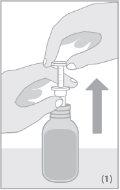
Open the bottle. Before starting to measure the amount of oral solution, make sure the white plunger is inside the transparent dosing body of the syringe. To measure the amount, use one hand to hold the dosing body and with the other hand pull the plunger until it reaches the mark corresponding to the amount in milliliters (ml) prescribed by your doctor (Figure 1).
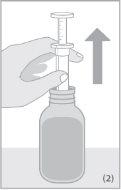
Remove the syringe from the bottle by holding the dosing body (Figure 2).
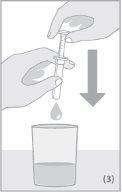
Empty the contents of the syringe into a glass of water by pushing the plunger. Make sure you have drunk all the contents of the glass. The contents of the syringe can also be administered directly from the syringe into the mouth, or emptied into a spoon (Figure 3).
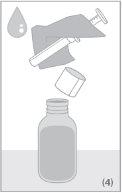
Wash the syringe with water after use and close the bottle with the plastic screw cap (Figure 4).
Instructions for correct administration with 1 ml and 3 ml syringes with an adapter
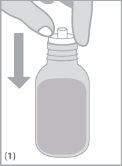
Open the bottle and push the syringe adapter firmly into the neck of the bottle (Figure 1).
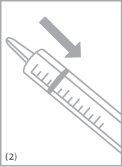
Take the syringe and pull the plunger slightly (Figure 2).
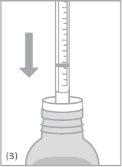
Push the tip of the syringe into the adapter opening. Push the plunger slowly to introduce air into the bottle (Figure 3).
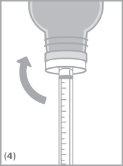
Put the bottle upside down without removing the syringe (Figure 4).
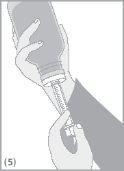
Pull the plunger and fill the syringe with a quantity of solution slightly greater than the prescribed dose (Figure 5)
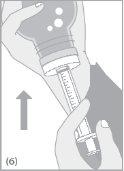
If bubbles appear in the syringe, keep the bottle upside down, push the plunger slightly and pull it back again. Repeat this operation until there are no bubbles in the syringe (Figure 6).
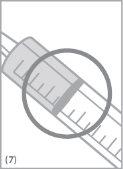
Push the plunger slowly until it reaches the graduation mark corresponding to the amount in milliliters (ml) prescribed by your doctor (Figure 7).
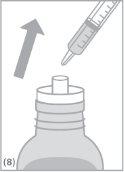
Put the bottle upright and remove the syringe (Figure 8).
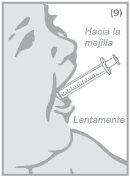
In the case of small children, gently place the tip of the syringe in the child’s mouth towards the inner cheek. Push the plunger slowly and let the child swallow the contents of the syringe. The contents of the syringe can also be emptied into a glass of water or a baby’s bottle. Make sure the child drinks all the contents of the glass or bottle (Figure 9).
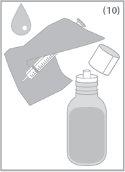
Wash the syringe with water after use and close the bottle with the plastic screw cap (Figure 10).
Duration of treatment
- Levetiracetam Actavis Group is used as chronic treatment. You should continue treatment with Levetiracetam Actavis Group for the time indicated by your doctor.
- Do not stop your treatment without your doctor’s recommendation, as your fits may increase.
If you take more Levetiracetam Actavis Group than you should
Possible side effects of an overdose of Levetiracetam Actavis Group are drowsiness, agitation, aggression, decreased alertness, respiratory inhibition and coma.
Contact your doctor if you have taken more Levetiracetam Actavis Group than you should. Your doctor will establish the best possible treatment for the overdose.
If you forget to take Levetiracetam Actavis Group
Contact your doctor if you have missed one or more doses.
Do not take a double dose to make up for forgotten doses.
If you stop treatment with Levetiracetam Actavis Group
Stopping treatment with Levetiracetam Actavis Group should be done gradually to avoid an increase in fits. If your doctor decides to stop your treatment with Levetiracetam Actavis Group, he/she will give you instructions for the gradual withdrawal of Levetiracetam Actavis Group, if he/she decides to suspend your treatment with this medicine.
If you have any further questions on the use of this medicine, ask your doctor or pharmacist.
4. Possible Adverse Effects
Like all medicines, this medicine can cause adverse effects, although not all people suffer from them.
Tell your doctor immediately, or go to the emergency department of your nearest hospital if you experience:
- weakness, dizziness, or difficulty breathing, as these may be signs of a severe allergic reaction (anaphylaxis);
- swelling of the face, lips, tongue, or throat (Quincke's edema);
- flu-like symptoms and rash on the face followed by a prolonged rash with high temperature, elevated liver enzyme levels in blood tests, and an increase in a type of white blood cells (eosinophilia) and enlarged lymph nodes (Drug Hypersensitivity Reaction with Eosinophilia and Systemic Symptoms (DRESS));
- symptoms such as low urine output, fatigue, nausea, vomiting, confusion, and swelling of legs, arms, or feet, as these may be signs of sudden renal function decrease:
- a skin rash that can form blisters and may appear as small targets (dark central spots surrounded by a lighter area, with a dark ring around the edge) (erythema multiforme);
- a widespread rash with blisters and skin peeling, especially around the mouth, nose, eyes, and genitals (Stevens-Johnson syndrome);
- a more severe form that causes skin peeling on more than 30% of the body surface (toxic epidermal necrolysis);
- signs of severe mental changes or if someone around you notices signs of confusion, drowsiness (drowsiness), amnesia (memory loss), memory impairment (forgetfulness), abnormal behavior, or other neurological signs including involuntary or uncontrolled movements. These may be symptoms of encephalopathy.
The most frequently reported adverse effects are nasopharyngitis, drowsiness (feeling of sleep), headache, fatigue, and dizziness.
Adverse effects such as drowsiness, fatigue, and dizziness may be more frequent when treatment is initiated or the dose is increased. However, these adverse effects should decrease over time.
Very Common:may affect more than 1 in 10 people
- nasopharyngitis;
- drowsiness (feeling of sleep), headache.
Common:may affect up to 1 in 10 people
- anorexia (loss of appetite);
- depression, hostility or aggression, anxiety, insomnia, nervousness or irritability;
- seizures, balance disorder, dizziness (feeling of instability), lethargy (lack of energy and enthusiasm), tremor (involuntary tremor);
- vertigo (feeling of rotation);
- cough;
- abdominal pain, diarrhea, dyspepsia (heavy digestion, heartburn, and acidity), vomiting, nausea;
- skin rash;
- asthenia/fatigue (feeling of weakness).
Uncommon:may affect up to 1 in 100 people
- decrease in platelet count, decrease in white blood cells;
- weight loss, weight gain;
- suicidal attempt and suicidal thoughts, mental disorders, abnormal behavior, hallucinations, anger, confusion, panic attack, emotional instability/mood changes, agitation;
- amnesia (memory loss), memory impairment (lack of memory), abnormal coordination/ataxia (altered movement coordination), paresthesia (tingling), attention disorders (loss of concentration);
- diplopia (double vision), blurred vision;
- elevated/abnormal values in liver function tests;
- hair loss, eczema, itching;
- muscle weakness, myalgia (muscle pain);
- injury.
Rare:may affect up to 1 in 1,000 people
- infection;
- decrease in all types of blood cells;
- severe allergic reactions (DRESS, anaphylactic reaction (important and severe allergic reaction), Quincke's edema (swelling of face, lips, tongue, and throat));
- decrease in sodium concentration in blood;
- suicide, personality disorders (behavioral problems), abnormal thinking (slow thinking, difficulty concentrating);
- delirium;
- encephalopathy (see subsection "Tell your doctor immediately" for a detailed description of symptoms);
- epileptic seizures may worsen or occur more frequently;
- uncontrolled muscle spasms affecting the head, torso, and limbs, difficulty controlling movements, hyperkinesia (hyperactivity);
- change in heart rhythm (electrocardiogram);
- pancreatitis (inflammation of the pancreas);
- liver failure, hepatitis (inflammation of the liver);
- sudden decrease in renal function;
- skin rash, which can lead to blisters that may appear as small targets (dark central spots surrounded by a lighter area, with a dark ring around the edge) (erythema multiforme), a widespread rash with blisters and skin peeling, especially around the mouth, nose, eyes, and genitals (Stevens-Johnson syndrome), and a more severe form that causes skin peeling on more than 30% of the body surface (toxic epidermal necrolysis);
- rhabdomyolysis (muscle tissue breakdown) and increased blood creatine phosphokinase. The prevalence is significantly higher in Japanese patients compared to non-Japanese patients;
- limping or difficulty walking;
- a combination of fever, muscle stiffness, unstable blood pressure and heart rate, confusion, low level of consciousness (may be signs of a disorder called malignant neuroleptic syndrome). The prevalence is significantly higher in Japanese patients compared to non-Japanese patients.
Very Rare:may affect up to 1 in 10,000 people
- unwanted and repetitive thoughts or feelings or the urge to do something over and over again (obsessive-compulsive disorder).
Reporting of Adverse Effects
If you experience any type of adverse effect, consult your doctor or pharmacist, even if it is a possible adverse effect that is not listed in this prospectus. You can also report them directly through the national reporting system included in Appendix V. By reporting adverse effects, you can contribute to providing more information on the safety of this medicine.
5. Storage of Levetiracetam Actavis Group
Keep this medicine out of sight and reach of children.
Do not use this medicine after the expiration date that appears on the packaging, label, or blister after EXP. The expiration date is the last day of the month indicated.
Do not use 7 months after the first opening of the bottle.
This medicine does not require special storage conditions.
Medicines should not be thrown away through wastewater or household waste. Ask your pharmacist how to dispose of the packaging and medicines that are no longer needed. This will help protect the environment.
6. Contents of the Package and Additional Information
Composition of Levetiracetam Actavis Group
- The active ingredient is levetiracetam. Each ml contains 100 mg of levetiracetam.
- The other components are: sodium citrate, citric acid monohydrate, methylparaben (E218), propylparaben (E216), ammonium glycyrrhizate, glycerin, glycerol (E422), liquid maltitol (E965), potassium acesulfame (E950), grape flavor (contains propylene glycol), purified water
Appearance of the Product and Package Contents
Levetiracetam Actavis Group 100 mg/ml oral solution is a clear, slightly brownish-yellow solution.
The 300 ml glass bottle of Levetiracetam Actavis Group (for children from 4 years, adolescents, and adults) is packaged in a cardboard box with a 10 ml oral syringe (graduated every 0.25 ml).
The 300 ml glass bottle of Levetiracetam Actavis Group (for infants and young children from 6 months to less than 4 years of age) is packaged in a cardboard box with a 3 ml oral syringe (graduated every 0.1 ml) and a syringe adapter.
The 300 ml glass bottle of Levetiracetam Actavis Group (for infants from 1 month to less than 6 months of age) is packaged in a cardboard box with a 1 ml oral syringe (graduated every 0.05 ml) and a syringe adapter.
Not all package sizes may be marketed.
Marketing Authorization Holder
Actavis Group PTC ehf.
Dalshraun 1
220 Hafnarfjörður
Iceland
Manufacturer
Balkanpharma-Troyan AD
1 Krayrechna Str,
Troyan 5600
Bulgaria
You can request more information about this medicine by contacting the local representative of the marketing authorization holder:
Belgium/Belgique/Belgien Teva Pharma Belgium N.V./S.A./AG Tel: +32 38207373 | Lithuania UAB Teva Baltics Tel: +370 52660203 |
| Luxembourg/Luxemburg Teva Pharma Belgium N.V./S.A./AG Belgium/Belgien Tel: +32 38207373 |
Czech Republic Teva Pharmaceuticals CR, s.r.o. Tel: +420 251007111 | Hungary Teva Gyógyszergyár Zrt. Tel: +36 12886400 |
Denmark Teva Denmark A/S Tlf: +45 44985511 | Malta Teva Pharmaceuticals Ireland Ireland Tel: +44 2075407117 |
Germany ratiopharm GmbH Tel: +49 73140202 | Netherlands Teva Nederland B.V. Tel: +31 8000228400 |
Estonia UAB Teva Baltics Eesti filiaal Tel: +372 6610801 | Norway Teva Norway AS Tlf: +47 66775590 |
Greece Specifar A.B.E.E. Τηλ: +30 2118805000 | Austria ratiopharm Arzneimittel Vertriebs-GmbH Tel: +43 1970070 |
Spain Teva Pharma, S.L.U. Tel: +34 913873280 | Poland Teva Pharmaceuticals Polska Sp. z o.o. Tel: +48 223459300 |
France Teva Santé Tél: +33 155917800 | Portugal Teva Pharma - Produtos Farmacêuticos, Lda. Tel: +351 214767550 |
Croatia Pliva Hrvatska d.o.o. Tel: +385 13720000 | Romania Teva Pharmaceuticals S.R.L. Tel: +40 212306524 |
Ireland Teva Pharmaceuticals Ireland Tel: +44 2075407117 | Slovenia Pliva Ljubljana d.o.o. Tel: +386 15890390 |
Iceland Teva Pharma Iceland ehf. Sími: +354 5503300 | Slovakia TEVA Pharmaceuticals Slovakia s.r.o. Tel: +421 257267911 |
Italy Teva Italia S.r.l. Tel: +39 028917981 | Finland Teva Finland Oy Puh/Tel: +358 201805900 |
Cyprus Specifar A.B.E.E. Ελλάδα Τηλ: +30 2118805000 | Sweden Teva Sweden AB Tel: +46 42121100 |
Latvia UAB Teva Baltics filiale Latvija Tel: +371 67323666 | United Kingdom (Northern Ireland) Teva Pharmaceuticals Ireland Ireland Tel: +44 2075407117 |
Belgium/Belgique/Belgien Actavis Group PTC ehf. Iceland/Islande/Island Tél/Tel: +354 5503300 | Lithuania UAB Teva Baltics Tel: +370 52660203 |
| Luxembourg/Luxemburg Actavis Group PTC ehf. Islande/Island Tél/Tel: +354 5503300 |
Czech Republic Teva Pharmaceuticals CR, s.r.o. Tel: +420 251007111 | Hungary Teva Gyógyszergyár Zrt. Tel: +36 12886400 |
Denmark Teva Denmark A/S Tlf: +45 44985511 | Malta Teva Pharmaceuticals Ireland Ireland Tel: +44 2075407117 |
Germany Actavis Group PTC ehf. Island Tel: +354 5503300 | Netherlands Actavis Group PTC ehf. IJsland Tel: +354 5503300 |
Estonia UAB Teva Baltics Eesti filiaal Tel: +372 6610801 | Norway Teva Norway AS Tlf: +47 66775590 |
Greece Specifar A.B.E.E. Τηλ: +30 2118805000 | Austria ratiopharm Arzneimittel Vertriebs-GmbH Tel: +43 1970070 |
Spain Actavis Group PTC ehf. Islandia Tel: +354 5503300 | Poland Teva Pharmaceuticals Polska Sp. z o.o. Tel: +48 223459300 |
France Actavis Group PTC ehf. Islande Tél: +354 5503300 | Portugal Actavis Group PTC ehf. Islândia Tel: +354 5503300 |
Croatia Pliva Hrvatska d.o.o. Tel: +385 13720000 | Romania Teva Pharmaceuticals S.R.L. Tel: +40 212306524 |
Ireland Teva Pharmaceuticals Ireland Tel: +44 2075407117 | Slovenia Pliva Ljubljana d.o.o. Tel: +386 15890390 |
Iceland Teva Pharma Iceland ehf. Sími: +354 5503300 | Slovakia TEVA Pharmaceuticals Slovakia s.r.o. Tel: +421 257267911 |
Italy Actavis Group PTC ehf. Islanda Tel: +354 5503300 | Finland Teva Finland Oy Puh/Tel: +358 201805900 |
Cyprus
Τηλ: +357 22583333 | Sweden Teva Sweden AB Tel: +46 42121100 |
Latvia UAB Teva Baltics filiale Latvija Tel: +371 67323666 | United Kingdom (Northern Ireland) Teva Pharmaceuticals Ireland Ireland Tel: +44 2075407117 |
Date of the last revision of this prospectus: {MM/AAAA}.
Other sources of information
Detailed information about this medicine is available on the European Medicines Agency website: http://www.ema.europa.eu.
- Country of registration
- Active substance
- Prescription requiredYes
- Manufacturer
- This information is for reference only and does not constitute medical advice. Always consult a licensed doctor before taking any medication. Oladoctor is not responsible for medical decisions based on this content.
- Alternatives to LEVETIRACETAM ACTAVIS GROUP 100 mg/ml ORAL SOLUTIONDosage form: INJECTABLE PERFUSION, 100 mgActive substance: levetiracetamManufacturer: Ucb PharmaPrescription requiredDosage form: INJECTABLE PERFUSION, 100 mg/mlActive substance: levetiracetamManufacturer: Ucb PharmaPrescription requiredDosage form: ORAL SOLUTION/SUSPENSION, 100 mgActive substance: levetiracetamManufacturer: Ucb PharmaPrescription required
Alternatives to LEVETIRACETAM ACTAVIS GROUP 100 mg/ml ORAL SOLUTION in other countries
The best alternatives with the same active ingredient and therapeutic effect.
Alternative to LEVETIRACETAM ACTAVIS GROUP 100 mg/ml ORAL SOLUTION in Polska
Alternative to LEVETIRACETAM ACTAVIS GROUP 100 mg/ml ORAL SOLUTION in Ukraina
Online doctors for LEVETIRACETAM ACTAVIS GROUP 100 mg/ml ORAL SOLUTION
Discuss dosage, side effects, interactions, contraindications, and prescription renewal for LEVETIRACETAM ACTAVIS GROUP 100 mg/ml ORAL SOLUTION – subject to medical assessment and local rules.









